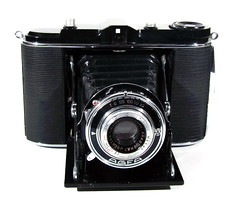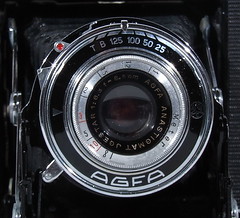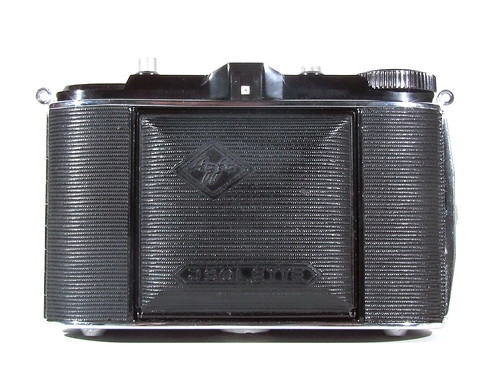Difference between revisions of "Isolette"
m (Noted 'T' shutter control, in picture caption) |
m (Moved Jsorette/Jsolette/Isolette thing into section on that model.) |
||
| Line 1: | Line 1: | ||
| − | The '''Isolette''' | + | The '''Isolette''' is a compact horizontal-[[folding]] camera for twelve 6×6 cm (2¼-inch square) pictures (or sixteen 4.5×6 cm (2¼×1⅝ inch) pictures, with the first model of the camera) on [[120 film]]. It was made by [[Agfa]] Kamerawerk AG, Munich, Germany, from 1938.<ref name=McK>{{McKeown12}} p25.</ref> It was the first of a series of cameras lasting until about 1960. |
| − | + | <!--Commenting out this whole section. The TOC will serve more or less the same function --~~~~ | |
| − | |||
| − | |||
| − | |||
| − | <!--Commenting out this whole section. | ||
==Isolette camera models== | ==Isolette camera models== | ||
The [[Agfa]] Isolette models include: | The [[Agfa]] Isolette models include: | ||
| Line 30: | Line 26: | ||
}} | }} | ||
</div> | </div> | ||
| − | This first model was a dual format camera | + | This first model was a dual format camera. It has hinged masks in the film chamber (they pivot around the spindle of the film rollers each side of the film gate), to change it from the 6×6 cm format to 4.5×6 cm. There is also a mask for the viewfinder. |
| + | |||
| + | It first came on the market as the '''Iso''r''ette''' (embossed in the leatherette of the front door/lens bed as <small>''J''SORETTE</small><ref>The name is written as Jsolette simply because the capital "I" resembles a "J" in German typography of the time. The embossing on the camera was changed to a modern "I" in 1937. See: [http://www.kindredroots.com/What/germanletters/germanletters_caps.htm Old German Letters]</ref> ), but the name was changed to '''Isolette''' (again, marked on the camera as <small>'''''J''SOLETTE'''</small>) within a year. | ||
| + | |||
| + | One of the distinctive features of the camera is the top housing, made of a plastic called "Trolitan"; the post-War camera has a cast aluminium top housing. This camera also has loops to attach a strap, the only version of the Isolette to have these. | ||
| − | |||
Different lens and shutter combinations were available, allowing a wide range of levels of specification. All have front-element focusing. The shutter release is on the body. This model was called the "Soldatenkamera" (soldier's camera) in Germany during the War. | Different lens and shutter combinations were available, allowing a wide range of levels of specification. All have front-element focusing. The shutter release is on the body. This model was called the "Soldatenkamera" (soldier's camera) in Germany during the War. | ||
| − | |||
* Year of release: 1938<ref name=McK></ref> | * Year of release: 1938<ref name=McK></ref> | ||
| Line 44: | Line 42: | ||
The earliest cameras have Vario shutters which are not labelled as such. | The earliest cameras have Vario shutters which are not labelled as such. | ||
| − | |||
{|class=plainlinks align="center" | {|class=plainlinks align="center" | ||
Revision as of 21:30, 31 October 2011
The Isolette is a compact horizontal-folding camera for twelve 6×6 cm (2¼-inch square) pictures (or sixteen 4.5×6 cm (2¼×1⅝ inch) pictures, with the first model of the camera) on 120 film. It was made by Agfa Kamerawerk AG, Munich, Germany, from 1938.[1] It was the first of a series of cameras lasting until about 1960.
Contents
Isolette (1938-42)
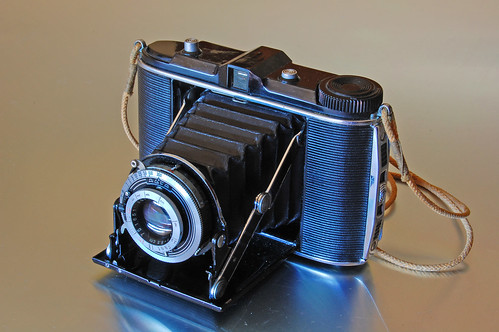
|
| First model Isolette. image by Raúl Sá Dantas (Image rights) |
This first model was a dual format camera. It has hinged masks in the film chamber (they pivot around the spindle of the film rollers each side of the film gate), to change it from the 6×6 cm format to 4.5×6 cm. There is also a mask for the viewfinder.
It first came on the market as the Isorette (embossed in the leatherette of the front door/lens bed as JSORETTE[2] ), but the name was changed to Isolette (again, marked on the camera as JSOLETTE) within a year.
One of the distinctive features of the camera is the top housing, made of a plastic called "Trolitan"; the post-War camera has a cast aluminium top housing. This camera also has loops to attach a strap, the only version of the Isolette to have these.
Different lens and shutter combinations were available, allowing a wide range of levels of specification. All have front-element focusing. The shutter release is on the body. This model was called the "Soldatenkamera" (soldier's camera) in Germany during the War.
- Year of release: 1938[1]
- Film Format: 12 exp. 6x6 or 16 exp. 4.5x6 on 120 type rollfilm.
- Shutter: Vario, Pronto, Prontor II, Compur or Compur-Rapid.
- Lens: Igestar 8.5cm f/6.3, Apotar 8.5cm f/4.5 or Solinar 8.5cm f/4.5.
- Viewfinder: reverse-Galilean viewfinder
The earliest cameras have Vario shutters which are not labelled as such.
|
|
| ||||||
| Isolette, first model, about 1938.
Images by Süleyman Demir (Image rights) | ||||||||
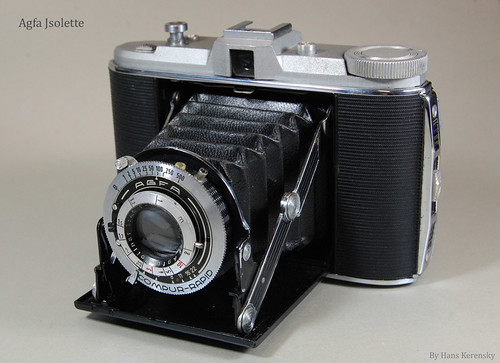
|
| Post-War Isolette image by Hans Kerensky (Image rights) |
Isolette (1945-50)
The first post-War model was made from 1945 till 1950. It is not adjustable to 4.5×6 cm format. The top housing of this model is cast from Hydronalium (Nüral: an aluminium alloy). There were less lens and shutter combinations, offering only the higher levels of specification (no Agnar, nor Vario or Pronto shutters). Most of the lenses are still uncoated.[1] Some of the shutters available are synchronised. The camera has an accessory shoe (above the viewfinder).
- Year of release: 1945
- Film Format: 12 exp. 6x6 on 120 film.
- Shutter: Prontor, Prontor-S or Compur-Rapid.
- Lens: Apotar 8.5cm f/4.5 or Solinar 8.5cm f/4.5.
- Double exposure prevention.
- Viewfinder: reverse-Galilean viewfinder

|
| Isolette V, with f/4.5 Agnar and Vario shutter. The upright metal strip at the side of the shutter is the release. Note the control added to offer 'T' as well as 'B' shutter. image by Raúl Sá Dantas (Image rights) |
Isolette V (1950-52)
The Isolette V has Agfa's entry-level f/4.5 Agnar triplet lens, and only low-specification shutters (Pronto or Vario). However, the lens is now coated on many examples, and the shutters are synchronised, with a PC socket. The accessory shoe is either on top of the viewfinder or to one side of it (on earlier examples). There is no body-mounted shutter release.
Succeeding models
After 1950, several different models of the Isolette were made at the same time, with different levels of specification:
- the Isolette I
- the Isolette II
- the Isolette III
- the Super Isolette
- the Isolette L
Notes
- ↑ 1.0 1.1 1.2 McKeown, James M. and Joan C. McKeown's Price Guide to Antique and Classic Cameras, 12th Edition, 2005-2006. USA, Centennial Photo Service, 2004. ISBN 0-931838-40-1 (hardcover). ISBN 0-931838-41-X (softcover). p25.
- ↑ The name is written as Jsolette simply because the capital "I" resembles a "J" in German typography of the time. The embossing on the camera was changed to a modern "I" in 1937. See: Old German Letters
